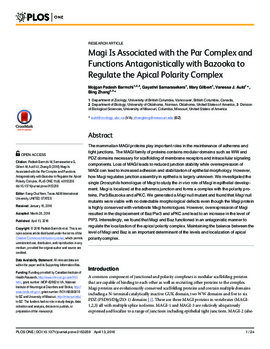| dc.contributor.author | Mojgan Padash Barmchi | |
| dc.contributor.author | Gayathri Samarasekera | |
| dc.contributor.author | Mary Gilbert | |
| dc.contributor.author | Vanessa J. Auld | |
| dc.contributor.author | Bing Zhang | |
| dc.date.accessioned | 2017-03-04T01:59:55Z | |
| dc.date.available | 2017-03-04T01:59:55Z | |
| dc.date.issued | 2016-04-13 | |
| dc.identifier.citation | Padash Barmchi M, Samarasekera G, Gilbert M, Auld VJ, Zhang B (2016) Magi Is Associated with the Par Complex and Functions Antagonistically with Bazooka to Regulate the Apical Polarity Complex. PLoS ONE 11(4): e0153259. doi:10.1371/journal.pone.0153259 | en_US |
| dc.identifier.uri | https://hdl.handle.net/11244/49234 | |
| dc.description | We would like to thank Drs. Dave Bilder, Chris Doe, Denise Montell, Gregory Longmore, Vivian Budnik, Herbert Jäckle and Andreas Wordarz for generously providing reagents, the Bloomington Drosophila Stock Center, and Dr. Jody Summers for the generous permission to use her Olympus FV1000 confocal microscope. We thank Kate O’Connor-Giles and Scott Gratz for advice on CRISPR/Cas9 and for providing their U6-3 vector. We thank the TRiP at Harvard Medical School (NIH/NIGMS R01-GM084947) for providing stocks and the Developmental Studies Hybridoma Bank (University of Iowa, Department of Biology, Iowa City) for antibodies. This research was supported by grants from the Canadian Institute of Health Research (MOP-82862 to VJA) and in part from the National Institutes of Health/National Institute of Neurological Disorders and Stroke (RO1-NS060878 to BZ) and by an internal fund from the University of Missouri (to BZ). | en_US |
| dc.description | | en_US |
| dc.description.abstract | The mammalian MAGI proteins play important roles in the maintenance of adherens and tight junctions. The MAGI family of proteins contains modular domains such as WW and PDZ domains necessary for scaffolding of membrane receptors and intracellular signaling components. Loss of MAGI leads to reduced junction stability while overexpression of MAGI can lead to increased adhesion and stabilization of epithelial morphology. However, how Magi regulates junction assembly in epithelia is largely unknown. We investigated the single Drosophila homologue of Magi to study the in vivo role of Magi in epithelial development. Magi is localized at the adherens junction and forms a complex with the polarity proteins, Par3/Bazooka and aPKC. We generated a Magi null mutant and found that Magi null mutants were viable with no detectable morphological defects even though the Magi protein is highly conserved with vertebrate Magi homologues. However, overexpression of Magi resulted in the displacement of Baz/Par3 and aPKC and lead to an increase in the level of PIP3. Interestingly, we found that Magi and Baz functioned in an antagonistic manner to regulate the localization of the apical polarity complex. Maintaining the balance between the level of Magi and Baz is an important determinant of the levels and localization of apical polarity complex. | en_US |
| dc.language.iso | en_US | en_US |
| dc.publisher | PLos One | |
| dc.relation.ispartofseries | PLoS ONE 11(4): e0153259 | |
| dc.relation.uri | http://www.plosone.org/article/info%3Adoi%2F10.1371%2Fjournal.pone.0153259 | |
| dc.rights | Attribution 3.0 United States | |
| dc.rights.uri | https://creativecommons.org/licenses/by/3.0/us/ | |
| dc.subject | Cell membranes,Membrane proteins,Imaginal discs,Hyperexpression techniques,Cell polarity,Cloning,Immunoprecipitation,Drosophila melanogaster | en_US |
| dc.title | Magi Is Associated with the Par Complex and Functions Antagonistically with Bazooka to Regulate the Apical Polarity Complex | en_US |
| dc.type | Research Article | en_US |
| dc.description.peerreview | Yes | en_US |
| dc.description.peerreviewnotes | http://www.plosone.org/static/editorial#peer | en_US |
| dc.identifier.doi | 10.1371/journal.pone.0153259 | en_US |
| dc.rights.requestable | false | en_US |

